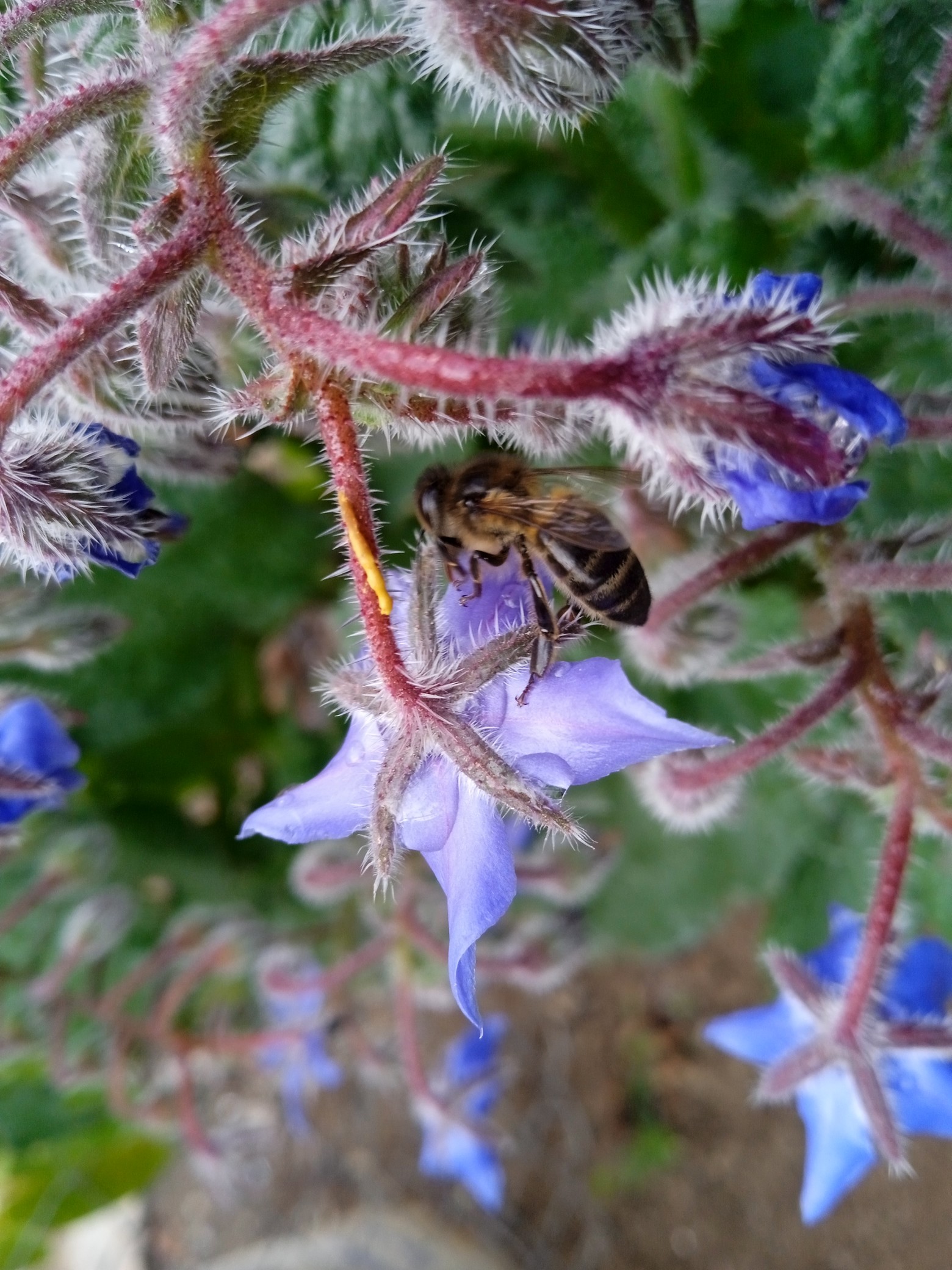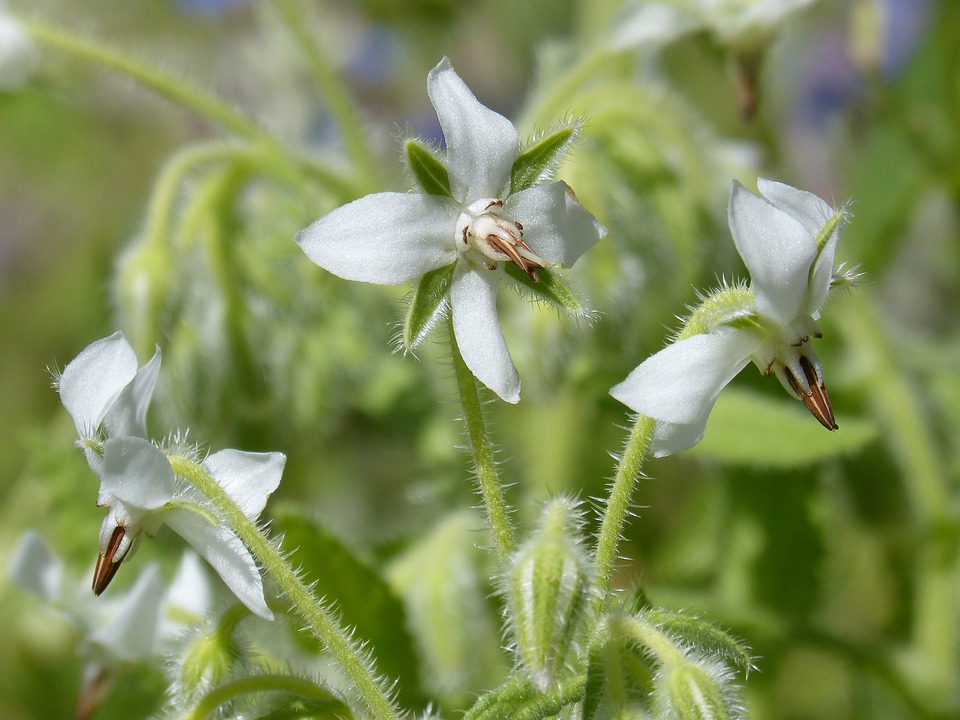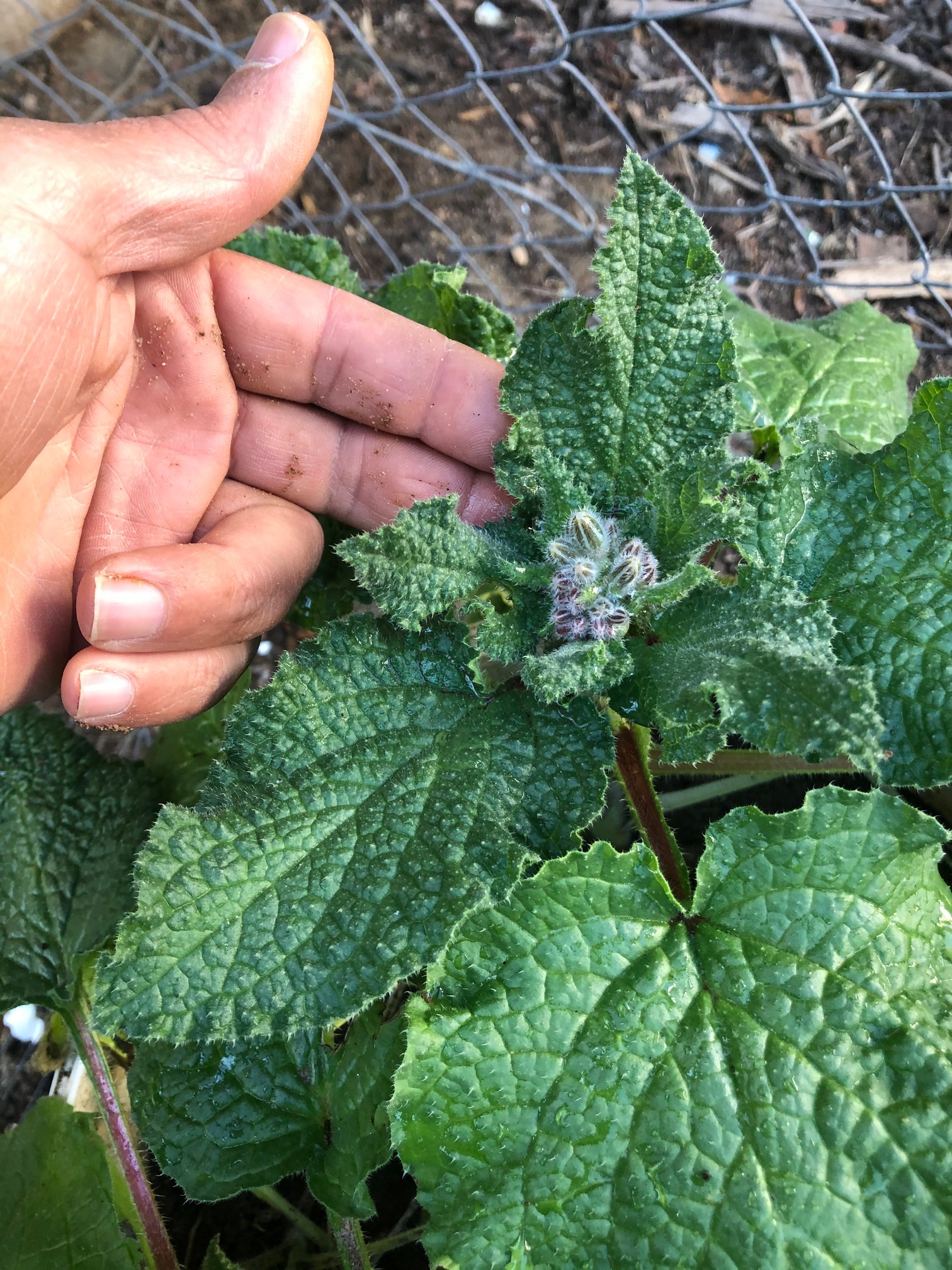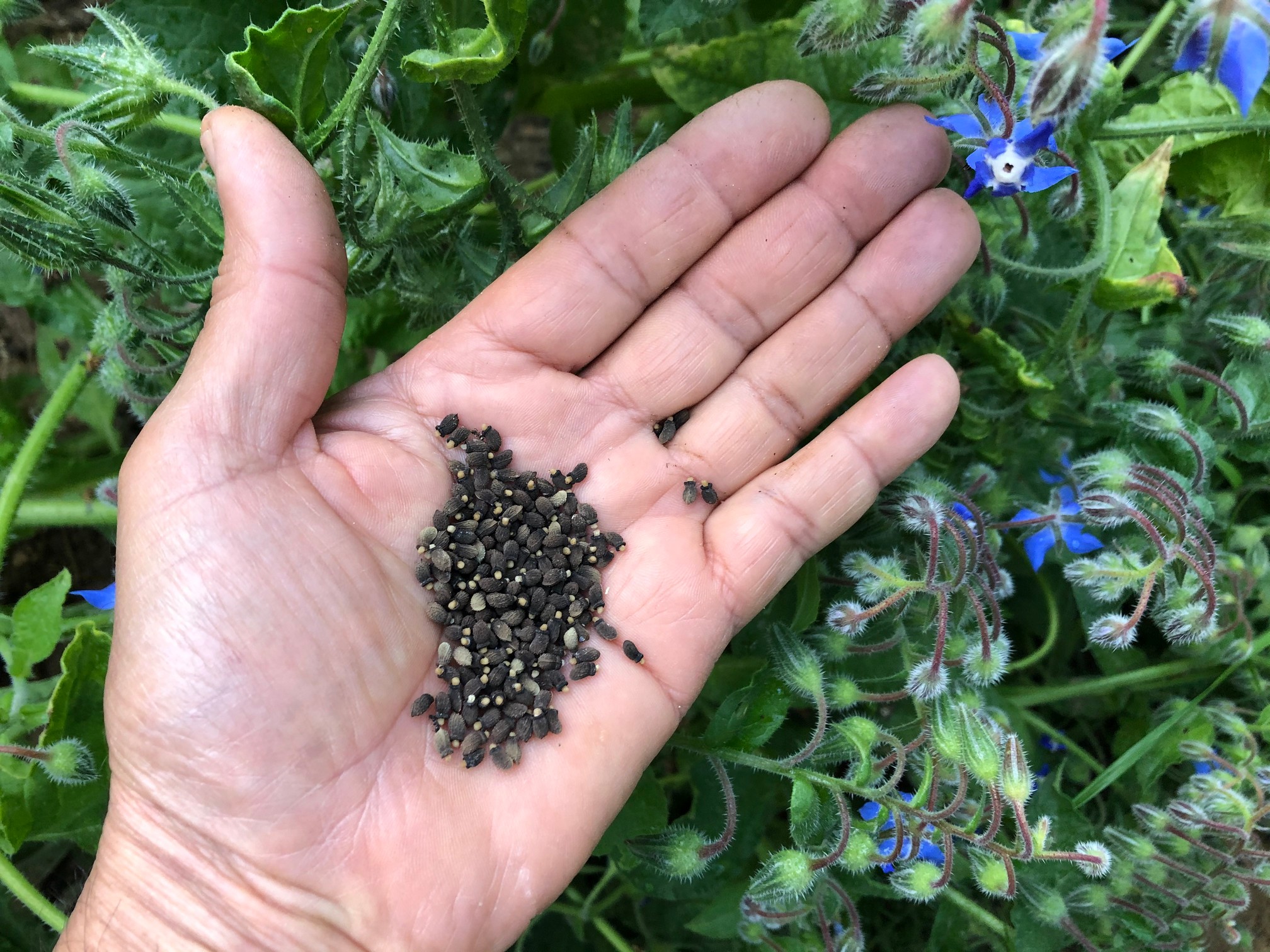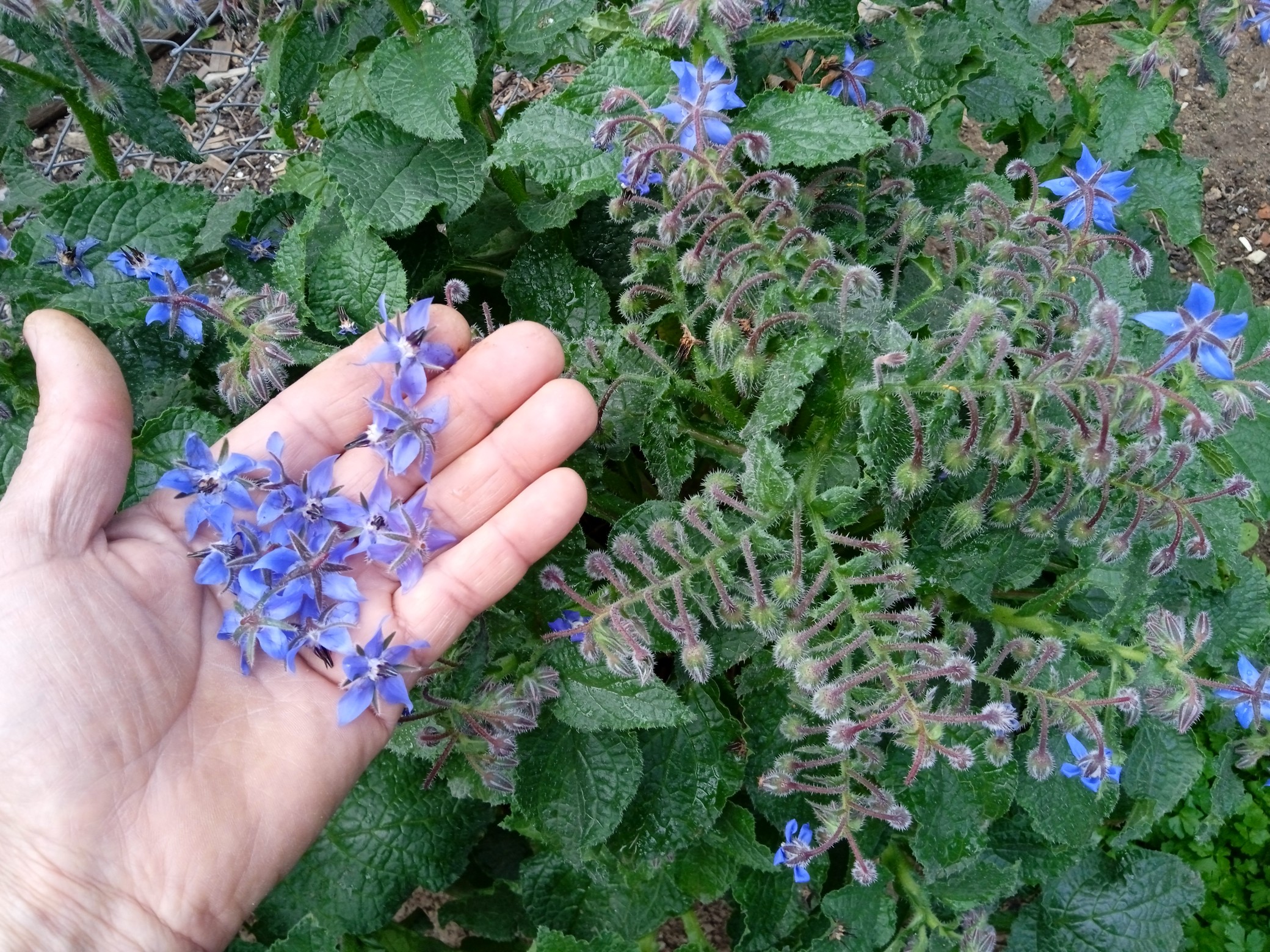With These basic tips apply to most herb container gardening, I will help you get off to a good start growing your own borage in containers, and enjoy harvesting its beautiful flowers!
Table of contents
Introduction to growing borage in containers
- Botanical Name: Borago officinalis
- Common Name: borage
- Family: Boraginaceae
- Plant Type: Annual, herb
- Hardiness Zones: 2 – 11 (USDA)
- Sun Exposure: Full sun to partial shade
- Soil Type: Well-draining soil
- Soil pH: 4.5–8.5
- Maturity: 50-70 days
- Height: 20 to 35 inches
- Spacing: 12 to 18 inches apart
- Bloom Time: Early Summer
This Mediterranean native herb also sometimes called a starflower, and bee bread. It is used for medicinal purposes as well as many garden uses. Growing borage (Borago officinalis) in containers is so easy. It is a powerful herb for healing and companion planting, and growing borage adds a touch of beauty to your garden. Best eaten fresh, its tender young leaves and stems have a delicious cucumber-like flavor, and the flowers make tasty and attractive garnishes. Not only is borage a beautiful addition to your garden, it has some benefits too. Borage is an excellent companion plant. This plant will attract bees as well as other beneficial bugs, and provides a valuable source of nectar for them. As gardeners, we know how much important pollinators are to our garden.
Borage is also known to repel tomato worms and cabbage moths as well, and when planted near your squash it can improve their flavor. Borage has a strong fragrance and repels most insects that might eat it. This aromatic plant is also rich in nutrients like calcium and potassium, that's why borage is so useful and a must-have plant in our gardens for all it's benefits!
You need to know before you get started that once you grow borage, you will have it forever. This annual plant will self-seed itself and pop up every year. I don't consider borage invasive because it's far too beneficial to become problematic, and the best of all is that when a plant pops up that you don’t want it, it’s simple to pull and either eat or add to your compost pile. That's why I think borage is a must-have plant in our gardens!
Borage is an adaptable plant that thrives in any soil, requires low to moderate moisture, and can withstand drought conditions. This aromatic herb can grow in partial shade but, it prefers the sunlight, so choose an area in your home garden that gets full sun, at least part of the day.
. The benefits of growing borage .
Borage has attractive green foliage, lovely star-shaped blue flowers and woolly stems. In the garden, This beautiful plant attracts bees of all kinds. The benefits of borage are so many from repelling pests such as hornworms, attracting pollinators, until aiding any plants it is interplanted with, by increasing resistance to pests and disease. Borage has a reputation for improving the flavor and growth of strawberries.
For borage containers gardening, you only need good containers with draining holes, good soil mix, and appropriate seed (or transplant) varieties to grow. In addition, for providing 5 to 8 hours of full sun, watering is critical. You may need to water daily in hot weather, as the soil can dry out quickly. The best of all: Containers are generally low-maintenance!
Different Varieties of Borage
There are the most varieties of Borage to grow.
Common Borage (Borago officinalis)
It is the most common variety, the leaves are blue. Common Borage is the most familiar of the different types of Borage. Common Borage displays intensely blue blooms with contrasting black stamens.
Alba – (Borago officinalis ‘Alba’)
Alba Borage have white flowers. It is also known as white Borage; Alba is a great choice if you’re looking for a plant with intense white blooms. Stalks of Alba tend to be a bit sturdier than common Borage and the plant usually blooms later in the season than its blue cousin. It blooms later in the season that blue types, with lovely white color flowers. It is a bit sturdier than common Borage.
Borage leaves
The leaves and stems of the borage plant are covered with small bristle-like hairs. The leaves are ovate in shape and range in length from 2 to 6 inches in length, with larger leaves towards the bottom of the plants. Young Borage leaves are crunchy and can be used both in the fresh as well as dried forms to make a refreshing tea. The leaves can also be eaten raw, and added to salads with a mild cucumber flavor.
Borage flowers
The beautiful star shaped flowers of borage plant have five triangular shaped petals, and a fine hair covered calyx. The petals start out pink, and gradually change to the blue color as they mature. The mature flower color is a bright azure blue. This amazing aromatic herb is also available with white flower petals, but this color is less common.
Borage flowers hang downwards on the plant, and are visible from underneath the plant. These tiny blue flowers have a fresh cucumber flavor and can be eaten too. Borage flowers are often used to decorate desserts and cocktails, and make colorful additions to salads and many dishes.
Borage blooms for a long period of time throughout the growing season, and flowers in sequence.
Watch the amazing benefits of borage plant video
A step by step guide to growing borage in containers
Borage is a versatile annual herb that is very easy to grow in containers. It is easily grown from seed started indoors or directly sown in the garden after the frost is past. Borage prefers warmer seasons. You have to wait to to sow your Borage seeds after the last frost, the soil should be warm enough!
Growing borage in containers requires the same preparation as growing borage in the ground. All you need is a healthy soil rich in good and organic nutrients, at least 6 hours of sunlight and containers to grow.
Choosing containers
Choosing a good sized container for your plants to grow in is very important!
Starting off with the right container, with the right size, is key for your new plant to thrive. Large plants in small containers dry out quickly and become pot-bound, while small plants in large pots look odd and can have trouble regulating soil moisture. When it comes to choosing your containers, they must be big enough. Big container means more soil which can stay moist longer and hold more nutrients. But Small containers or pots may look pretty but they can negatively affect the way your plants grow. You have to know that the more room in a container you can give them, the better they grow and produce.You can browse this Big Collection of Containers and choose the right container size for your plants.
- When you are choosing a container to grow borage, be sure to choose a container that allows enough room for your plant to grow and a soil depth enough that will provide plenty of root space.
- Select a container 12 inches deep and wide or larger. Borage forms a taproot and need large and deep containers to grow in.
- The container requires good drainage. If your container doesn’t come with drainage holes then you’ll need to drill these by yourself. So the excess of water needs to be able to pass through the container so that the roots of your vegetables are not sitting in stagnant water.
Preparing the soil for your containers
To get the best results in herb containers gardening , you will need to fill your containers with good quality potting soil.
A simple method to follow is to mix equal parts of soil and high-quality compost.
But most Organic Gardeners as me like to create their own mix of soil so that we know exactly what is in it!
I add some aged chicken manure to the garden soil, as the chicken manure adds organic matter and increases the water holding improve the texture and structure of your soil, and encourage the growth of of the plants.
Watch the benefits of chicken manure video
Borage is one of the easiest plants to grow in containers and grow effusively. Plant maintenance is also more convenient with containers, there are fewer problems with weeds and it is so easy to control. Growing borage in containers is a great way to enjoy . It is also a great choice if space is limited. Not just Container herb gardens are beautiful and bountiful. Borage plant with it's beautiful edible flowers delight the eye and add beauty to your garden.
Where to buy borage seeds?
Borage seeds are black-brown, oblong, grooved on the sides with a little round hat on one end.
You can find Borage Seeds available at Amazon. Always make sure you buy them from a reliable source to ensure the seeds are viable!
Planting borage seed in containers
- Position the container in full sun, and make sure the area is protected from wind. You can put it near a wall or a structure to break the wind. Borage plants can blow around easily!
- Plant seeds directly in the container soon after the last frost in spring.
- Poke a hole and sow two to three seeds 1cm (½”) deep.
- Cover them with soil.
- Water well and expect to see seedlings emerge in 5-10 days.
- Ensure the potting mix in the container is moist till the plants are established.
- Borage seedlings can survive light frosts. They don't need much care. You can add mulch around them to help the soil retain water to prevent plants from wilting.
Transplanting borage seedlings in containers
Borage is typically planted directly into a sunny spot in the garden, as the plant doesn't usually respond well to being transplanted. However, if you have started your borage indoors, you can successfully transplant borage seedlings as long as it is done with special care to not harm the roots.
You should transplant your borage seedlings to a large container once your borage plants get between 3 – 5 inches tall. This will take approximately 6 to 8 weeks after you first plant your borage seeds indoors.
- Mix compost into the top 4 to 6 inches of soil so that your borage seedling has plenty of nutrients to help it avoid shock when it is transplanted.
- Remove it carefully from the pot with as much soil as possible to prevent disturbing the roots.
- Dig to a depth of about 3 to 4 inches. Borage has shallow roots.
- Dig a hole that is about 4 inches deep and 3 inches wide in the container.
- Place the root ball of one of your borage seedlings into the hole you dug so that your new borage plant is positioned upright.
- Cover the roots of your plant with soil to secure your plant in place. Pat the soil firmly around the base of your plant.
- Water the soil until it is moist around your plants. Continue to water young plants daily to keep the soil moist.
- After transplanting your borage seedlings into the container provide a thick covering of mulch to help them ward off cold, disease and pests, and better retain water during the hot summer months. If you notice that a late frost may occur in your area, to protect hem from wilting and dying simply cover your borage plants with a freeze protection.
My advice!
You can reduce the potential of damaging your borage plant's roots by starting plants in peat pots. Peat pots can be transplanted with the plant so your borage seedlings roots aren't disturbed, and keep in mind that it's best to transplant borage plants when they are young to reduce root damage!
Watering and fertilizing borage plants
Watering:
Borage requires even regular water until established. Once established the soil can dry out between waterings. Water your plants deeply whenever the top 1 to 2 inches of potting media feels dry to the touch. Check often during hot, dry weather, as containerized plants dry quickly, but be careful when watering do not to let the soil become soggy, which promotes rot!
Fertilizing:
Borage does not require fertilizer, avoid soil rich in nitrogen or plants may not bloom. Fertilize with compost tea or a dilute solution of fish emulsion to give flowering plants a boost.
Borage plants care and maintenance
Care:
. Keep the container well weeded to avoid competition for moisture. Tall plants may require staking or support. .Remove faded flowers to prolong blooming.
Mulching:
. Mulch around borage to keep foliage off of the ground where it may rot.
Pruning:
. Prune back plants when they are 6 inches tall to encourage bushiness. You can prune back borage by one-half in midsummer, by doing this you will encourage new tender leaves and many flowers for late summer harvest!
Companion planting with borage
Borage plant is said to repel tomato worms and cabbage worms and this plant with its attractive blue flowers attracts beneficial insects, such as bees that we need as a great plant pollinators. Borage will attract these beneficial insects to your garden and benefit other plants, such as cucumber, zucchini and strawberries, that do require insect pollinators.
Not only borage is beneficial to bees, but can improve the quality of other plants, as beans, squash and peas. If it's grown in conjunction with them.
Borage plant diseases
Borage is relatively resistant to pests and diseases. Borage has a strong fragrance and repels most insects that might eat it. But, it still can be attacked by some that will render your plants sick and useless.
Powdery mildew is possibly the most common disease to disrupt your plant growth. It causes white spots on the leaves, and if left untreated, will begin to grow black mold spores. To prevent this disease, give your plants good air circulation and remove infected leaves to reduce the spread. Make sure your plants get plenty of sunlight and not over-watered. Remember always you have to water the soil, never the leaves and the flowers, water containers in the morning so the sun can dry them through the day.
When borage plant starts flowering, you can harvest frequently to encourage more bloom-production. The leaves and the flowers of borage are edible with a flavor like a cucumber. As the stalks and leaves are covered with fine, silvery hairs that tend to get pricklier as they mature . It’s wise to handle the plant with gloves while picking borage leaves. When picking borage leaves, select the young ones, which will have less of the little hairs. Just take a scissor and snip right below a cluster of blossoms.
To harvest the flowers Simply pull the flowers off with your fingers or clip them with scissors. Borage is used as either a fresh vegetable or a dried herb. As a fresh vegetable, borage, with a cucumber-like taste, is often used in salads or as a garnish.
Your borage plant will continue to produce side-shoots with more buds and flowers. Continual harvesting and deadheading will allow for a longer period of use!
Watch how to harvest borage flowers video
Collecting and storing borage seeds
Borage seeds are easy to find, but they need to be picked at the right time when they are ripe. After the pollination of flowers, the petals drop off and the sepals open out revealing four seeds within. They start off white and as they ripen they turn black and drop off, individually not all at once. This is the right time to collect the ripe borage seeds. Simply knock them off the plant with your finger into your hand or a container.
Store seeds in a cool dry place. Seeds will remain viable for 3-5 years.
Borage plant grows quickly, blooms almost continuously, and then in the end, will flop over and must be pulled. It’s an easy plant to pull. As borage is a big plant, you can lay it in the path of your garden where it can decompose slowly, and add organic matter to your soil, or you can toss it in the compost. You will improve your garden soil!
Now that you know how to grow borage in containers, you can grow this super herb in your garden or in your balcony garden containers it's so easy!
🛒 Quality Borage Seed 🛒
Here!
If you have any tips for growing borage, we'd love to hear them - please share them in the comments below!
This web site is a participant in the Amazon Services LLC Associates Program, an affiliate advertising program designed to provide a means for sites to earn advertising fees by advertising and linking to amazon. Some of the links to products on this site are affiliate links. These are products that I've used or recommend based from homesteading experience. I do make a small commission (at no extra cost to you) from these sales.(alert-warning)




